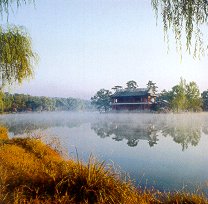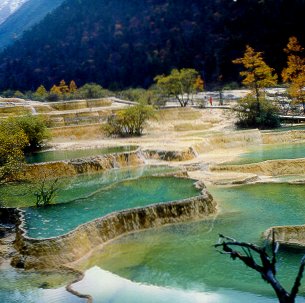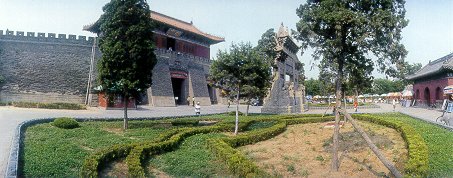| Contents
65. Hua Yen Sect (I)
- Hua Yen Sect (I)
65.1 Name
Hua-yen ( 華嚴 ) is the pronunciation of Flower Adornment, which
is translated from the Sanskrit word Avatamsaka, the name of one
of the most famous sutra in Buddhism. This sect takes its name from
the Avatamsaka Sutra, which is the principal text of the sect. Literally,
Avatamsaka means Flower Adornment, or Flower Garland, or Flower
Ornament.
The sect is also known as Hsien-shou ( 賢首 ) sect. Hsien-shou was
another name of the third patriarch, Master Fa-tsang ( 法藏 ), who
was so remarkable and respectful that people called this sect after
his name.
65.2 Development
Hua-yen is generally classified as a scholastic sect for its philosophical
approach in its teaching. It was originated in China and was established
by Master Tu-shun ( 杜順 ) (557-640 AD), and its started to flourish
at the time of the third patriarch Master Fa-tsang ( 法藏 ) (643-712
AD).
Shortly after the death of the fifth patriarch Tsung-mi ( 宗密 ),
Buddhism was suppressed in the Period of Five Dynasties. Under such
circumstances, no more Hua-yen master appeared and the school declined
in 9th century after flourishing for over 200 years in China.
65.3 The Patriarchs
The following five masters are important to the formation and development
of Hua-yen sect:
- Fa-shun ( 法順 ) 558-640 AD
Fa-shun was his Dharma name. As Tu was his last name, he was
also called Tu-shun ( 杜順 ). He was ordained by the Ch'an master
Tao-chen, and devoted himself to the Dhyana meditation practice.
With his great healing power and profound knowledge in Buddhism,
he was bestowed the honorary title 'the Holy one of the Imperial
Heart' by the Emperor. Because of his miraculous power, people
called him 'the Bodhisattva of Tun-huang' ( 敦煌菩薩 ).
 Tu-shun
did not follow a particular teacher in the hierarchy of this
school. He concentrated his study on Hua-yen and lived on Mount
Zhong-nan ( 終南山 ) for many years. He wrote the essay On
the Meditation of Dharmashatu. He established the concept
of 'Contemplating the Dharmadhatu' ( 一觀法界 ), which set the pattern
for the subsequent commentaries. He also established the concept
of 'Round Doctrine' ( 圓教 ), which reflects the totalistic view
in the Hua-yen sect. He was considered to be the first patriarch
in Hua-yen sect. Tu-shun
did not follow a particular teacher in the hierarchy of this
school. He concentrated his study on Hua-yen and lived on Mount
Zhong-nan ( 終南山 ) for many years. He wrote the essay On
the Meditation of Dharmashatu. He established the concept
of 'Contemplating the Dharmadhatu' ( 一觀法界 ), which set the pattern
for the subsequent commentaries. He also established the concept
of 'Round Doctrine' ( 圓教 ), which reflects the totalistic view
in the Hua-yen sect. He was considered to be the first patriarch
in Hua-yen sect.
- Chih-yen ( 智儼 ) 602-668 AD
Chih-yen, the successor of Tu-shun, is the second patriarch
of Hua-yen sect. He was also called Yun-hua ( 雲華 ) because he
often preached the Avatamsaka Sutra in Yun-hua temple. His important
writings include The Ten Mysteries in One Vehicle of Hua
Yen, The Fifty Questions and Answers of the Hua Yen Doctrine,
Notes and Commentaries on the Various Chapters of Hua Yen Sutra,
and A Search for the Profound Mysteries of Hua Yen
Sutra. Chih-yen was the one who proposed the Ten Mysteries,
which was perhaps his most important contribution in the development
of Hua-yen doctrines.
-
Fa-tsang ( 法藏 ) 643-712 AD
Among the disciples of Chih-yen, Fa-tsang was
definitely the most outstanding one. He was also called 'Hsien-shou'
( 賢首 ), which meant 'the head of the wise', a respectful name
given by his followers. He was given by the Emperor an honorary
title 'Kuo-i' ( 國一 ), which meant 'One in the State'.
He was also regarded as the most productive writer
among all Hua-yen masters, because he wrote one hundred volumes
of books and essays. He systematized and organized the Hua-yen
doctrines. Because of his tremendous effort in preaching and
writing on the Hua-yen doctrines, Hua-yen sect was also called
Hsien-shou sect ( 賢首宗 ).
In his youth, he assisted Hsuan-tsang ( 玄奘 ) and
I-tsing ( 義淨 ) in the translation work. However, he was greatly
impressed by the preaching of Chih-yen and became his disciple
in the Yun-hua Monastery. He was formally ordained at twenty-eight
when he was appointed the abbot of the newly built Tai-yuan
Monastery by the Empress Wu ( 武則天 ).
As he was so familiar with Buddhabhadra's translation
of Avatamsaka Sutra, he was invited to assist Sikshanamda in
the translation of the 80-fascicle Avatamsaka Sutra. It was
said that he preached the entire Avatamsaka Sutra more than
thirty times during his lifetime. His enlightening illustration
of Hua-yen doctrines with a golden lion in the writing On
the Golden Lion ( 金獅子章 ) will be elaborated in the following
chapters.
When he died at the age of seventy, a state funeral
was held in his honor since he had served as the National Preceptor
for four emperors in Tang Dynasty.
- Cheng-kuan ( 澄觀 ) 738-838 AD
He was called Master Ching-liang ( 清涼 ), which was the name
of the temple where he studied the Three Shastras of San-lun
sect under Master Hsuan-pi when he was young. He also studied
under many famous scholars and outstanding Zen masters. His
comprehensive knowledge covers almost all the doctrines of different
sects of his time, as reflected in his writing "A Prologue
to Hua Yen". Physically he was said to be a giant over
nine feet tall. He was ordained when he was fourteen. He traveled
to the central, western and northern China, and at last settled
in Hua Yen Monastery on Mount Wutai and preached there for many
years. Later generation of his followers respected him as the
incarnation of Bodhisattva Manjusri, and called him the Hua
Yen Bodhisattva ( 華嚴菩薩 ).
In 796 AD, he was invited by the Emperor to assist Prajna to
translate the 40-fascicle Avatamsaka Sutra. He was then granted
titles : 'Master in the Purple Robe', National Preceptor, Professor
Monk and the Chief of Monks. He lived to 102 years old and was
known to be the Imperial Master for six consecutive Emperors
in the Tang Dynasty.
He wrote over 400 essays and commentaries on Avatamsaka Sutra.
He was also the master of many distinguished disciples, who
respectfully called him 'the Master of Law'.
Cheng-kuan was born 27 years after Fa-tsang's death and could
never have studied under Fa-tsan. But interestingly he was considered
the fourth patriarch of the Hua-yen sect by the 'orthodox' Hua-yen
disciples.
- Tsung-mi ( 宗密 ) 780-841 AD
He was also called Master Kuei-feng ( 圭峰 ). He first studied
Confucian classics when he met Ch'an master Tao-yuan, and became
a monk and practiced meditation. He was deeply impressed by
the commentaries on Avatamsaka Sutra written by Cheng-kuan.
Later, he submitted himself to Cheng-kuan as his disciple. Though
he was the fifth patriarch of Hua-yen sect and was highly respected
by the Emperors and his disciples, his contribution to Hua-yen
was not on a par with those of the other four patriarchs.
65.4 The Principal Texts
The most important of the principal texts for this sect is the
Avatamsaka Sutra.
This sutra was expounded by Shakyamuni Buddha 21days after his
Enlightenment. The sutra was compiled by Bodhisattva Mansjuri and
his disciple Ananda, and was said to be kept in the dragon palace
in the heaven.
It was said that later on, the Sutra was found and read by Nagarjuna.
It was said that there were three volumes, including billions of
verses in many, many chapters in the first volume, 498,800 verses
in 1,200 chapters in the second, 100,000 verses in 38 chapters of
the last. Since the first two volumes were so huge and difficult
for ordinary people to study and understand, Nagarjuna brought the
last volume and circulated it in this world.
 When
this sutra was propagated to China in three versions, each being
translated by one of the three following great masters : When
this sutra was propagated to China in three versions, each being
translated by one of the three following great masters :
- Buddhabhadra in 420 AD - It has 36,000 verses in 60 chapters
(fascicles). As it is the first one translated in the Jin Dynasty,
it is called 'the old Sutra', or 'the Jin Sutra' ( 晉經 ).
- Siksananda - It has 45,000 verses in 80 chapters. It is also
known as 'the new sutra', or 'the Tang Sutra' ( 唐經 ) since it
was translated in the Tang Dynasty.
- Prajna - It has only 40 chapters and was also translated in
the Tang Dynasty later on and is thus called 'the later Sutra'.
Though all three versions are only part of the Sutra, the first
one is predominantly that for studying, and the other two are just
for reference.
There are other principal texts in the Hua-yen sect as well, such
as:
- Shastra on the Dasabhumi Sutra ( 十地經論 ) written by Vasubandhu
- The Sandhinirmocana Sutra ( 解密深經 )
|


 Tu-shun
did not follow a particular teacher in the hierarchy of this
school. He concentrated his study on Hua-yen and lived on Mount
Zhong-nan ( 終南山 ) for many years. He wrote the essay On
the Meditation of Dharmashatu. He established the concept
of 'Contemplating the Dharmadhatu' ( 一觀法界 ), which set the pattern
for the subsequent commentaries. He also established the concept
of 'Round Doctrine' ( 圓教 ), which reflects the totalistic view
in the Hua-yen sect. He was considered to be the first patriarch
in Hua-yen sect.
Tu-shun
did not follow a particular teacher in the hierarchy of this
school. He concentrated his study on Hua-yen and lived on Mount
Zhong-nan ( 終南山 ) for many years. He wrote the essay On
the Meditation of Dharmashatu. He established the concept
of 'Contemplating the Dharmadhatu' ( 一觀法界 ), which set the pattern
for the subsequent commentaries. He also established the concept
of 'Round Doctrine' ( 圓教 ), which reflects the totalistic view
in the Hua-yen sect. He was considered to be the first patriarch
in Hua-yen sect.
 When
this sutra was propagated to China in three versions, each being
translated by one of the three following great masters :
When
this sutra was propagated to China in three versions, each being
translated by one of the three following great masters :